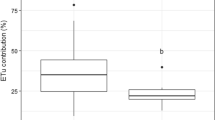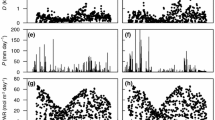Abstract
Average population growth in the African Sudanian belt is 3 % per year. This leads to a significant increase in cultivated areas at the expense of fallows and forests. For centuries, rural populations have been practicing agroforestry dominated by Vitellaria paradoxa parklands. We wanted to know whether agroforestry can improve local rainfall recycling as well as forest. We compared transpiration and its seasonal variations between Vitellaria paradoxa, the dominant species in fallows, and Isoberlinia doka, the dominant species in dry forests in the Sudanian belt. The fallow and dry forest we studied are located in northwestern Benin, where average annual rainfall is 1200 mm. Sap flow density (SFD) was measured by transient thermal dissipation, from which tree transpiration was deduced. Transpiration of five trees per species was estimated by taking into account the radial profile of SFD. The effect of the species and of the season on transpiration was tested with a generalized linear mixed model. Over the three-year study period, daily transpiration of the agroforestry trees, V. paradoxa (diameters 8–38 cm) ranged between 4.4 and 26.8 L day−1 while that of the forest trees, I. doka, (diameters 20–38 cm) ranged from 9.8 to 92.6 L day−1. Daily transpiration of V. paradoxa was significantly lower (15 %) in the dry season than in the rainy season, whereas daily transpiration by I. doka was significantly higher (13 %) in the dry season than in the rainy season. Our results indicate that the woody cover of agroforestry systems is less efficient in recycling local rainfall than forest cover, not only due to lower tree density but also to species composition.




Similar content being viewed by others
References
Aubreville A (1950) Flore forestière Soudano-Guinéenne AOF.-Cameroun-A.E.F. Éditions Géographiques, Maritimes et Coloniales, Paris
Aussenac G (2000) Interactions between forest stands and microclimate: ecophysiological aspects and consequences for silviculture. Ann For Sci 57:287–301
Bart AE, de Wal Van, Guyot A, Catherine EL, David AL, Steppe K (2015) Influence of temporospatial variation in sap flux density on estimates of whole-tree water use in Avicennia marina. Trees 29:215–222
Bayala J, Heng LK, van Noordwijkc M, Ouedraogo SJ (2008) Hydraulic redistribution study in two native tree species of agroforestry parklands of West African dry savanna. Acta Oecol 34:370–378
Bayala J, Sanou J, Teklehaimanot Z, Ouedraogo SJ, Kalinganire A, Coe R, van Noordwijkc M (2015) Advances in knowledge of processes in soil–tree–crop interactions in parkland systems in the West African Sahel: a review. Agric Ecosyst Environ 205:25–35
Blanchard M, Peugeot C, Seghieri J (2007) Structure et dynamique saisonnière de la végétation sur quatre types de couverts végétal représentatifs de la diversité du bassin versant de la Donga. Internship report, Montpellier
Bodart C, Brink AB, Donnay F, Lupi A, Mayaux P, Achard F (2013) Continental estimates of forest cover and forest cover changes in the dry ecosystems of Africa between 1990 and 2000. J Biogeogr 40:1036–1047
Bolker BM, Brooks ME, Clark CJ, Geange SW, Poulsen JR, Stevens MHH, White J-SS (2009) Generalized linear mixed models: a practical guide for ecology and evolution. Trends Ecol Evol 24:127–135
Compaoré H (2006) The impact of savannah vegetation on the spatial and temporal variation of the actual evapotranspiration in the Volta Basin, Navrongo, Upper East Ghana. Ecol Dev Ser 36:1–155
Delzon S, Sartore M, Granier A, Loustau D (2004) Radial profiles of sap flow with increasing tree size in maritime pine. Tree Physiol 24:1285–1293
Djossa B, Fahr J, Wiegand T, Ayihouenou BE, Kalko EK, Sinsin B (2008) Land use impact on Vitellaria paradoxa C.F. Gaerten. Stand structure and distribution patterns: a comparison of Biosphere Reserve of Pendjari in Atacora district in Benin. Agrofor Syst 72:205–220
Do F, Rocheteau A (2002) Influence of natural temperature gradients on measurements of xylem sap flow with thermal dissipation probes. 2. Advantages and calibration of noncontinuous heating system. Tree Physiol 22:649–654
Do F, Rocheteau A, Diagne AL, Goudiaby V, Granier A, Lhomme JP (2008) Stable annual pattern of water use by Acacia tortilis in Sahelian Africa. Tree Physiol 28:95–104
Dourma M, Wala K, Bellefontaine R, Batawila K, Guelly KA, Akpagana K (2009) Comparaison de l’utilisation des ressources forestières et de la régénération entre deux types de forêts claires à Isoberlinia au Togo. Bois et forêts tropicaux 302(4):5–19
Dupéré V, Lacourse E, Vitaro F, Tremblay RE (2007) Méthodes d’analyse du changement fondées sur les trajectoires de développement individuel. Bulletin de méthodologie sociologique. http://bms.revues.org/408. Accessed 09 Feb 2015
Dupraz C, Liagre F (2008) Agroforesterie: des arbres et des cultures. Ed. France Agricole, Paris
Dye PJ, Olbrich BW, Poulter AG (1991) The influence of growth rings in Pinus patula on heat pulse velocity and sap flow measurement. J Exp Bot 42:867–870
Eamus D, O’Grady AP, Hutley LB (2000) Dry season conditions determine wet season water use in the wet-dry tropical savannas of northern Australia. Tree Physiol 20:1219–1226
Faure P, Volkoff B (1998) Some factors affecting regional differentiation of the soils in the Republic of Benin (West Africa). Catena 32:281–306
Fernandez ME, Gyenge JE, Schlichter TM (2009) Water flux and canopy conductance of natural vs. planted forests in Patagonia, South America. Trees 23:415–427
Ford CR, McGuire MA, Mitchell RJ, Teskey RO (2004) Assessing variation in the radial profile of sap flux density in Pinus species and its effect on daily water use. Tree Physiol 24:241–249
Gartner BL, Meinzer FC (2005) Structure-function relationships in sapwood water transport and storage. In: Zwieniecki M, Holbrook NM (eds) Vascular transport in plants. Elsevier Academic Press, Oxford, pp 307–332
Glèlè Kakaï R, Akpona TJD, Assogbadjo AE, Gaoue OG, Chakeredza SP, Gnanglè CP, Mensah GA, Sinsin B (2011) Ecological adaptation of the shea butter tree (Vitellaria paradoxa C.F. Gaertn.) along climatic gradient in Benin, West Africa. Afr J Ecol 49:440–449
Granier A (1985) Une nouvelle méthode pour la mesure du flux de sève brute dans le tronc des arbres. Ann Sci For 42:193–200
Granier A (1987) Evaluation of transpiration in a Douglas-fir stand by means of sap flow measurements. Tree Physiol 3:309–320
Gwali S, Okullo JBL, Eilu G, Nakabonge G, Nyeko P, Vuzi P (2012) Traditional management and conservation of shea trees (Vitellaria paradoxa subspecies nilotica) in Uganda. Environ Dev Sustain 14:347–363
Gyenge J, Fernandez ME, Sarasola M, Schlichter T (2011) Stand density and drought interaction on water relations of Nothofagus Antarctica: contribution of forest management to climate change adaptability. Trees 25:1111–1120
Hall JB, Aebischer DP, Tomlinson HF, Osei-Amaning E, Hindle JR (1996) Vitellaria paradoxa. A monograph. School of Agricultural and Forest Sciences, University of Wales Bangor, Bangor
Hatton TJ, Catchpole EA, Vertessy RA (1990) Integration of sap flow velocity to estimate plant water-use. Tree Physiol 6:201–209
INSAE-Bénin (Institut National de la statistique et de l’Analyse économique du Bénin) (2013) Résultats provisoires du quatrième Recensement Général de la Population et de l’Habitation (RGPH4). Rapport d’étude. INSAE
Isarangkool Na Ayutthaya S, Do FC, Pannengpetch K, Junjittakarn J, Maeght J-L, Rocheteau A, Cochard H (2010) Transient thermal dissipation method of xylem sap flow measurement: multi-species calibration and field evaluation. Tree Physiol 30:139–148
Issoufou HB, Rambal S, Le Dantec V, Oï M, Laurent JP, Saadou M, Seghieri J (2015) Is the WBE model appropriate for semi-arid shrubs subjected to clear cutting? Tree Physiol 35:197–208
James SA, Clearwater MJ, Meinzer FC, Goldstein G (2002) Heat dissipation sensors of variable length for the measurement of sap flow in trees with deep sapwood. Tree Physiol 22:277–283
Jiménez MS, Nadezhdina N, Cermák J, Morales D (2000) Radial variation in sap flow in five laurel forest tree species in Tenerife, Canary Islands. Tree Physiol 20:1149–1156
Köhler M, Dierick D, Schwendenmann L, Hölscher D (2009) Water use characteristics of cacao and Gliricidia trees in an agroforest in Central Sulawesi, Indonesia. Ecohydrol 2:520–529
Lawin EA (2007) Analyse climatologique et statistique du régime pluviométrique de la Haute Vallée de l’Ouémé à partir des données pluviographiques AMMA-CATCH Bénin. PhD thesis. Institut National Polytechnique de Grenoble
Leroux L (2012) Analyse diachronique de la dynamique paysagère sur le bassin supérieur de l’Ouémé (Bénin) à partir de l’imagerie Landsat et MODIS—Cas d’étude du communal de Djougou. Rapport ESCAPE 2012
Lu P, Muller WJ, Chacko EK (2000) Spatial variations in xylem sap flux density in the trunk of orchard-grown, mature mango trees under changing soil water conditions. Tree Physiol 20:683–692
Meinzer FC, Goldstein G, Andrade JL (2001) Regulation of water flux through tropical forest canopy trees: do universal rules apply? Tree Physiol 21:19–26
Meinzer FC, James SA, Goldstein G, Woodruff D (2003) Whole-tree water transport scales with sapwood capacitance in tropical forest canopy trees. Plant Cell Environ 26:1147–1155
Meinzer FC, Bond BJ, Warren JM, Woodruff DR (2005) Does water transport scale universally with tree size? Funct Ecol 19:558–565
Nadezhdina N, Nadezhdin V, Ferreira MI, Pitacco A (2007) Variability with xylem depth in sap flow in trunks and branches of mature olive trees. Tree Physiol 27:105–113
Poorter H, Niinemets U, Poorter L, Wright IJ, Villar R (2009) Causes and consequences of variation in leaf mass per area (LMA): a meta-analysis. New Phytol 182:565–588
Seghieri J, Vescovo A, Padel K, Soubie R, Arjounin M, Boulain N, de Rosnay P, Galle S, Gosset M, Mouctar AH, Peugeot C, Timouk F (2009) Relationships between climate, soil moisture and phenology of the woody cover in two sites located along the West African latitudinal gradient. J Hydrol 375:78–79
Seghieri J, Do FC, Devineau JL, Fournier A (2012) Phenology of woody species along the climatic gradient in west tropical Africa. In: Phenology and climate change. In Tech Open book Chapter 9. pp. 144–178. ISBN: 978-953-51-0336-3
Shinohara Y, Tsuruta K, Ogura A, Noto F, Hikaru Komatsu H, Otsuki K, Maruyama T (2013) Azimuthal and radial variations in sap flux density and effects on stand-scale transpiration estimates in a Japanese cedar forest. Tree Physiol 33:550–558
Spicer R, Gartner BL (2001) The effects of cambial age and position within the stem on specific conductivity in Douglas-fir (Pseudotsuga menziesii) sapwood. Trees 15:222–229
West GB, Brown JH, Enquist BJ (1999) A general model for the structure and allometry of plant vascular systems. Nature 400:664–667
Zhou GY, Huang ZH, Morris J, Li ZA, Collopy J, Zhang NN, Bai J-Y (2002) Radial variation in sap flux density as a function of sapwood thickness in two eucalyptus (Eucalyptus urophylla) plantations. Acta Bot Sin 44:1418–1424
Acknowledgments
This study was funded by the laboratory HydroSciences Montpellier (HSM UR050) of the French Research Institute for Development (IRD). The devices and measurements were funded jointly by the Observatory AMMA-CATCH African Monsoon Multidisciplinary Analysis—combining the Tropical Atmosphere and the Hydrological Cycle (www.amma-catch.org), the Universe Sciences Observatory-OREME (www.oreme.univ-montp2.fr), the project “Searching for Trade-offs between Production and the Ecosystem Services Provided by Agroforestry Systems” (Recherche de compromis entre productions et services écosystémiques fournis par les systèmes agroforestiers—SAFSE, http://safse.cirad.fr/), and the Mixed International Laboratory PICASS-EAU.
Author information
Authors and Affiliations
Corresponding author
Rights and permissions
About this article
Cite this article
Awessou, K.G.B., Peugeot, C., Rocheteau, A. et al. Differences in transpiration between a forest and an agroforestry tree species in the Sudanian belt. Agroforest Syst 91, 403–413 (2017). https://doi.org/10.1007/s10457-016-9937-8
Received:
Accepted:
Published:
Issue Date:
DOI: https://doi.org/10.1007/s10457-016-9937-8




